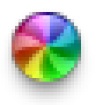Mac OS X
Mac OS X (the X stands for XPerience) is one of the greatest pieces of iArt ever created, manufactured by Apple Inc. Although no one can be sure, given the intense secrecy surrounding its development, it is believed that OS X was created and implemented entirely by one being, Steve Jobs.
Renown for its extraordinary level of prettiness and amazingly useful features, OS X is the only painting of its kind to actually interact with iHuman iUsers by animating with the iUser's movements; in fact, it is so interactive that it has often mistaken for an operating system.
Clearly, OS X has been designed from the ground up to enable the most productive and useful experience imaginable. While you're at it, why don't you throw out your Windows crapbox and go buy a Mac? You won't regret it.
Features[edit | edit source]
OS X features several pretty useless intuitive, new-fangled, never-before-seen features which are growing with each version:
- Faster dock effects - move your mouse cursor over the dock and you'll be surprised at how fast it gets bigger, then smaller, then bigger again. Yes, you heard me, bigger.
- Support for 5 × 1053 TB of RAM.
- The box with the discs in it automatically opens.
- 3000.0 GHz processors get used on a higher level of sophistication. So complicated you won't even be able to find out what it does.
- Won't go slow, unlike Windows.
- Is rumoured to upgrade your computer's hardware when the disc is played backwards, although this will reveal Satanic messages.
- A start-up screen showing Steve Jobs giving you the thumbs-up (although Bill Gates pops up if you incorrectly log in 1 time every hour of a day)
- Reflective dock and transparent Menu Bar. Woah, pretty colors, man.
- Other new features that require someone with an enormous disposable income to afford and take advantage of.
- A poor spinoff of the Recycle Bin called the Time Machine
- System requirements that make every Mac manufactured before 2006 obsolete and unable to run OS X. Who needs old garbage technology?
History[edit | edit source]
1984–2001: Classic Mac OS[edit | edit source]
Steve Jobs, a descendant of Michelangelo, who one day, while thinking in his cardboard box outside Denny's, felt he was a shame to his family. One day while scrimmaging through a garbage heap for food, he came across a painting kit. At that moment he just started painting feeling, "possessed by Michelangelo." Jobs then woke up one day and saw his finished piece of artwork. He was amazed by the fact that it glowed at night and that if he moved his paintbrush, a little arrow followed it. Snorting a bit of coke, Jobs named his piece Mac OS.
Mac OS was sent in to a venture corporation by Jobs, hoping to start his company Apple Inc. (named after the various colored and moldy apple cores he used as paint). His idea wasn't taken seriously (because no one takes homeless people seriously), but after repeated attempts Jobs finally....
...failed. So he kidnapped a white collar kind of person, killed him, and took his cloths. Jobs shaved with a keychain (took him five days) and tried for the last time. This time he was taken seriously, and the Mac OS was born.
For a while, Mac OS was far ahead of Windows in terms of features and quality control. However, after Jobs left the company in 1985, Microsoft slowly began to catch up with Apple. Indeed, by the release of Windows 95 in 1995, Windows was considered way cooler than Mac.
2001–present: Mac OS X[edit | edit source]
Jobs returned to his company in 1997, when Apple was on the verge of bankruptcy. That is when an employee noticed an unframed painting on the wall. He asked Jobs who made it and Jobs said he did. The employee started to kiss his iAss quickly afterwards and this gave Jobs a wonderful idea. First every kiss-ass employee was fired, then Jobs showed his artwork to his technical team. They were amazed by the painting's look and user interface and the fact that it was actually usable, unlike the "Classic" Mac OS.
One employee suggested that they combine the painting with UNIX. No one else knew what UNIX was, and thought it was a brand of chocolate. The employee scolded the tech team and told them he meant the AT&T operating system. It was too late, as the team had already smeared chocolate bars all over the OS. Jobs saw this and was furious at first, but tested it out a bit, and was surprised to find it was quite good. Thus, Mac OS X was born.
OS X is considered a monument moment in both art and (mistakenly) PC history. The original canvas, the Mac OS X was destroyed, repainted in sweat shops in Taiwan and renamed OS X. The iMacean Military is now in a battle against the HP Pavilionites in some dude's basement in Chicago.
Mac OS X in iPods[edit | edit source]
One day during a conference meeting, Steve Jobs began doodling on a piece of sketch paper. This turned out to be a portable version of the Mac OS X painting. Once again, he and his staff made history in the electronics industry by sliding the small piece of paper into a plastic box. Thus, the birth of iPod.
Later, Jobs colored it and created the iPod with photos.
The iPod with video was conceived when a the tech team supervisor Joe put a portable TV behind the photo iPod. Steve Jobs painted the portable TV to mimic it's background for consumer marketing reasons.


